The Saints: Powerful Intercessors or a Distraction from Focus on Jesus?
Reflections on the Communion of Saints from My Pilgrimage to the National Shrine of St. Thérèse in Darien, IL, and the Shrine of All Saints in Morton Grove, IL (May 15-18, 2025)
Saturday, May 17, 2025, was the 100th anniversary of the canonization of St. Thérèse of Lisieux. This is part of a series of posts in her honor.
As a father of five children under age eleven, who works full time, it is exceedingly rare to have the opportunity for an extended personal retreat. However, knowing that the 100th anniversary of St. Thérèse of Lisieux’s canonization was coming up, I scheduled a retreat for myself from Thursday May 15 to Sunday May 18 in Illinois, making all the arrangements months in advance. I had no idea that Illinois was a pilgrimage site. But, as it turns out, the National Shrine and Museum of St. Thérèse in Darien, Illinois, has more first and second class relics of St. Thérèse than any other location on earth outside of Lisieux, France.
The National Shrine and Museum of St. Thérèse in Darien, Illinois, has more first and second class relics of St. Thérèse than any other location on earth outside of Lisieux, France.
On Friday, May 16, I arrived at the small museum when it opened at 10:00 am, and took my time strolling around looking at such gems as Thérèse’s First Communion prayer book from 1884; a map of North America drawn by Thérèse at age twelve in 1895; a piece of the gown she wore when she entered the Carmel of Lisieux in 1888; a piece of the habit she wore for her profession of vows in 1890; two scraps of paper with Thérèse’s actual handwriting; and many more items (See the video tour and photos at the end of this article to get an immersive feel for the space). But, most of my time was spent praying in front of a beautiful golden reliquary which housed five different relics of Thérèse, each encased in its own golden rose. This reliquary was surrounded by a strikingly massive wood carving featuring key scenes from Thérèse’s life which must have been more than thirty feet wide. The Shrine’s website states it is the “largest wood carving of a religious nature in the United States.”
As I got up to head to daily Mass around 11:00 am, I noticed a full size exact replica of Thérèse’s cell with plexiglass windows that allowed you to peek inside (a ‘cell’ is how those in monastic life refer to their small, modestly appointed living quarters) with a sign that noted there were some second class relics inside, including the original door to Thérèse’s cell. However, much to my dismay there was no access to the cell. I inquired at the museum’s gift shop whether I could request a private tour of the museum and the cell in particular. I was given a phone number to call, however the minimum size for group tours was twenty. Feeling rather discouraged at this news, I headed across the parking lot to the Shrine Church for Mass. My ‘prayers’ before Mass would more properly be classified as complaining to Thérèse about why I couldn’t get access to the cell replica. I sensed in my heart that Thérèse responded as follows. These are the exact phrases I wrote down in that moment: “How close do you want to be to me? I have a mission for you, and I pray for it, and for you. You are my little brother, my friend, and my co-missionary of the ‘way of confidence and love’. I will give you access you never thought possible, that you can’t even imagine — an All-Access Pass.”
“I will give you access you never thought possible, that you can’t even imagine — an All-Access Pass.”
I didn’t know what that meant, but it was consoling to know of Thérèse’s prayers for me. As I sat down in my seat after Communion, I began to pray. I rarely have any sort of spiritual or emotional response when I receive Communion. But, when I received the Eucharist at that Mass, I experienced an intense series mental images: (1) A sense of the Real Presence of Jesus radiating from within me; (2) A parallel image of the presence of Jesus radiating from within all of his saints in heaven; followed by (3) An image of myself and all the saints in heaven simultaneously resting in the heart of Jesus. As these simultaneous images converged in my mind of Jesus in us, and us in Jesus, I felt a deep sense that I couldn’t get any closer to Thérèse and all the saints than that! Even praying with a first class relic is not as close to the saints as being within the heart of Jesus where they, too, reside for all eternity. With that, I was at peace that I was not meant to have access to Thérèse’s original door this trip, but that I had access to something far greater — to the very Eucharistic heart of Jesus.
I had access to something far greater — to the very Eucharistic heart of Jesus.
After Mass, I walked back across the parking lot to the museum, and read Story of a Soul in front of the large golden reliquary for about an hour. I then walked back through the gift shop, and one of the workers said, “Let me introduce you to our business manager. Maybe he can help.” She led me to a gentleman in the back office on the other side of the building, to whom I explained that I understood there were no group tours available, but if an opportunity to see the cell replica became available, he could find me praying in front of Thérèse’s relics for the next several hours until they closed for the day at 4:00 pm. At 3:00 pm, he found me praying and asked, “Will you be here at ten o’clock tomorrow morning? Fr. Bob Colaresi will meet you.” I expressed my gratitude, confirmed I would be there, and informed my advocate in the gift shop of this amazing development. She rejoiced with me, but I could also sense some surprise on her face. I said, “Is it rare to have a private tour with Fr. Bob?” She said, “Fr. Bob is out of town a lot traveling related to St. Thérèse; he was the director of the Shrine and the Society of the Little Flower from 1992 to 2020; and he presided over the U.S. tour of Thérèse’s relics in 1999-2000. So, that’s pretty special!”
I met Fr. Bob the next morning, on May 17, the 100th anniversary to the day of Thérèse’s canonization, and we ended up talking for forty-five minutes about Thérèse, a mere twenty feet from her relics and the surrounding wooden tableau of her life. He later told me it was a refreshing meeting for him because the biggest question most Shrine visitors have is, “Why did Thérèse send me a pink rose instead of a red one?” Then, he said, “So, you wanted to see her cell?” He led me to the thick, white, wooden gate surrounding the entrance to the cell, and presented his key. As we walked forward, into the replica of the anteroom where Thérèse would meet with novices, he began to tell me about how he came into possession of the original door frame, a section of original floor tiles, and the original door to Thérèse’s third cell in which she wrote her famous autobiography Story of a Soul. He visits Lisieux often to lead pilgrimages, and has frequent contact with the archivist of the Carmel of Lisieux. It happened that during a needed renovation for safety reasons, the tile and other items had to be removed, and it was at this juncture the items were offered to Fr. Bob to bring back to the States for public veneration at the Shrine.
Fr. Bob then said, “I have to head to a meeting, but I’ll be back to get you in fifteen minutes.” Then, I had an opportunity to pray sitting on a small stool with the bed a few inches to my left, and the original cell door about a foot to my right — sitting in a spot with the identical view that Thérèse would have had writing Story of a Soul. They even had a large photograph in the window frame of the view Thérèse would have had of the courtyard from her cell! In that moment, I sensed that Thérèse was saying, “Remind the Church that the spiritual life is so simple. It all comes down to surrender. If you miss that, you miss everything.”
In that moment, I sensed that Thérèse was saying, “Remind the Church that the spiritual life is so simple. It all comes down to surrender. If you miss that, you miss everything.”
When Fr. Bob came back, I thanked him for his time and reiterated what an honor it was to have access to the cell. Then, I was on the road to the Shrine of All Saints in Morton Grove, Illinois.
I had an appointment at 12:45pm, and made it just in time. Although the Shrine of All Saints has more than 3,200 saint relics, I was most focused on one relic in particular. A large 3-4” curl of Thérèse’s hair which was cut by her sister Céline when Thérèse entered Carmel. It is complete with the seal of the Carmelite coat of arms verifying its authenticity. As I approached, Fr. Dennis O’Neill even lifted the plexiglass case around the relic, to show the group that the case had a distinct smell of roses. I have never personally experienced the smell of roses in relation to Thérèse’s intercession, but this was unmistakable. I also prayed next to three second class relics of one of my primary patrons, St. Joan of Arc; a second class relic of one of the sixteen Carmelite martyrs of Compiegne, nuns who were guillotined toward the end of the French Revolution in 1794; and relics of forty of the Cristero martyrs, killed by the Mexican government between 1926 and 1929. The Cristero saints’ relics included St. Miguel Pro, whose cry before his death of ‘Viva Cristo Rey’ or ‘Long Live Christ the King’ echoed throughout Mexico, awakening the soul of the nation with 40,000 people lining the streets for his funeral; as well as St. José Luis Sánchez del Río, the fourteen-year old Cristero martyr, whose story has always captivated me.
I attended the 4:00pm Vigil Mass at the Shrine of All Saints that evening, and was struck by how the readings and songs seemed to line up with all the relics that surrounded the perimeter of the church. The first reading was from the book of Acts, chapter fourteen, which said, “After Paul and Barnabas had proclaimed the good news to that city… They strengthened the spirits of the disciples and exhorted them to persevere in the faith, saying, ‘It is necessary for us to undergo many hardships to enter the kingdom of God.’ ” The bones of Paul and Barnabas were located in the back left of the Shrine. One of the lines of the responsorial psalm from Psalm 145 was, “Your kingdom is an everlasting kingdom; your rule endures for all generations.” I was surrounded by thousands of relics from every generation of Church history!
I was surrounded by thousands of relics from every generation of Church history!
The most impactful moment of the Mass was when I received Communion. As I did so, my eyes welled up with tears once again as I reflected on Thérèse’s final Communion on August 19, 1897. When the priest said Ecce Agnus Dei (“Behold the Lamb of God”), tears fell from her eyes as she looked upon the Host with deep adoration. What a sharp contrast to how much it pained her to forego receiving the Eucharist due to her advanced illness in her final month of life. I also thought of Joan of Arc’s final Communion on the morning of her execution which was described by the court notary, Guillaume Manchon: “She wept greatly and devoutly at receiving the Body of Christ.” I received Communion about thirty feet from both a second class relic of Joan of Arc and a first class relic of Thérèse, and was literally surrounded by the relics of thousands more saints who would have gladly given their lives for their belief in the Real Presence of Christ in the Eucharist. I could sense their intercession palpably. The last song of the Mass was “To Jesus Christ, Our Sovereign King,” the third verse of which says, “To you and to your Church great King, we pledge our hearts’ oblation, until before your throne we sing in endless jubilation.” This was followed by the chorus, “Christ Jesus, Victor! Christ Jesus, Ruler! Christ Jesus, Lord and Redeemer!” I was singing this with tears in my eyes looking at the relics of the forty Cristero martyrs, many of whose final words were “Viva Cristo Rey.”
By all accounts, this was a normal Mass. There were normal people, some of whom were very reverently focused, others of whom were wrangling in their small children like me at most Masses. There was normal music with some of the congregation singing loudly and others completely silent. Like all parishes, some left right after Communion and others stayed to pray after Mass. Some were no doubt aware of the thousands of amazing relics which surrounded them, and for other long-time parishioners the relics have become nothing more than wallpaper in the background — hardly noticed at all. Yet, just like the relics in that Shrine, it is in the normal everyday ‘messiness’ of our lives that the saints surround us, and encourage us by both their prayers and their witness.
Yet, just like the relics in that Shrine, it is in the normal everyday ‘messiness’ of our lives that the saints surround us, and encourage us by both their prayers and their witness.
We are indeed as Hebrews 12:1 says, “surrounded by so great a cloud of witnesses.” It goes on to say, “Let us also lay aside every weight, and sin which clings so closely, and let us run with perseverance the race that is set before us, looking to Jesus the author and perfecter of our faith…” (v.1-2). The Catechism of the Catholic Church, paragraph 1370, states, “To the offering of Christ are united not only the members still here on earth, but also those already in the glory of heaven. In communion with and commemorating the Blessed Virgin Mary and all the saints, the Church offers the Eucharistic sacrifice.”
Our deep connection to the saints through the Eucharist is not mere conjecture. It is a tenet of our faith. The saints are our friends and mentors, our companions and guides, who cheer us on in our earthly pilgrimage to heaven.
The saints are our friends and mentors, our companions and guides, who cheer us on in our earthly pilgrimage to heaven.
Could we get to heaven without them? Sure. Do they distract us from Jesus? Hardly. If the saints are God’s greatest works of art, then to admire them is to admire the Artist. Furthermore, to admire the way they followed Jesus inspires us to follow Him ever closer! In short, it would be an incalculable impoverishment to ignore the saints because they show us by their lives and examples that holiness is possible. Not just in the abstract, but in reality — in the concrete circumstances of our lives, and in the face of seemingly insurmountable obstacles. Each saint is like a lens through which we can see aspects of the life and character of Christ that we have may missed. Mother Teresa reminds us of Christ’s love for the poor in a unique way. St. Paul reminds us of Christ’s missionary zeal for the salvation of souls. Teresa of Avila and John of the Cross remind us of the deep intimacy to be found in the contemplation of Christ. Thérèse reflects Christ’s humility, and reminds us of the gospel command that we must be childlike to enter the Kingdom of Heaven. Joan reflects Christ’s own innocence in the face of a rigged trial, and his fidelity to the Father to the bitter end. But, more than anything, they teach us by their unwavering loyalty that Christ is King, that faith is stronger than even death, and that the only fitting response to such a Good Father is total surrender to his love and mercy. May we surrender our hearts to Jesus, not in part, but completely, that we may one day see him face to face, surrounded by all the saints and angels of heaven.
Me with Thérèse’s Original Cell Door & the Large Relic of Thérèse’s Hair:
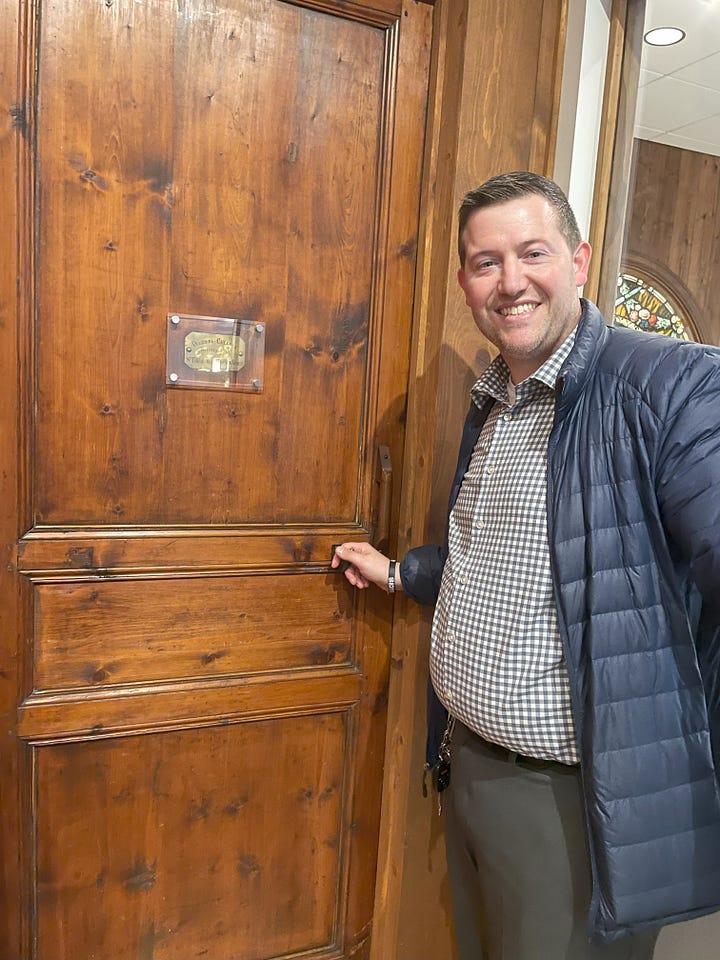

INFORMATION ABOUT THE TWO SHRINES MENTIONED IN THIS ARTICLE
THE NATIONAL SHRINE & MUSEUM OF ST. THÉRÈSE
Darien, IL
The National Shrine and Museum of St. Thérèse in Darien, Illinois, has the most first and second class relics of St. Thérèse of Lisieux than any place on earth outside of Lisieux, France. Their Carmelite Spiritual Center offers workshops and retreats throughout the year. Enjoy their 40 acres of lovely grounds with a lake, a Carmelite Meditation Garden, a walking path with 16 beautiful statues, and Stations of the Cross. Tours available for groups of 20 or more. Gift shop located at the entrance of the museum. SEE PHOTOS BELOW.
For more information on visiting the National Shrine & Museum of St. Thérèse, visit: https://www.littleflower.org/national-shrine-and-museum-of-st-therese/
For information about the Carmelite Spiritual Center, visit:
https://carmelitespiritualcenter.org/
THE SHRINE OF ALL SAINTS
Morton Grove, IL
The Shrine of All Saints in Morton Grove, Illinois, is home to more than 3,200 saint relics, making it the second largest collection of such relics in America, after the 5,000 relics at St. Anthony’s Shrine in Pittsburgh, Pennsylvania. Only the Vatican itself holds more saint relics. The third largest collection in the U.S. is the 1,200 relics held at the Maria Stein Shrine of the Holy Relics in Maria Stein, Ohio. SEE PHOTOS BELOW.
For more information on visiting the Shrine of All Saints, visit
VIDEO & PHOTOS FROM THE NATIONAL SHRINE & MUSEUM OF ST. THÉRÈSE (DARIEN, IL)
Video Tour of the Museum:
Exterior of Shrine & Museum, & Interior of the Shrine Church:
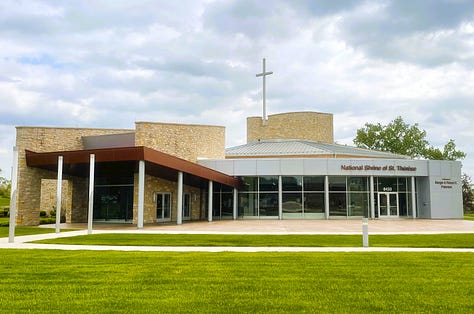
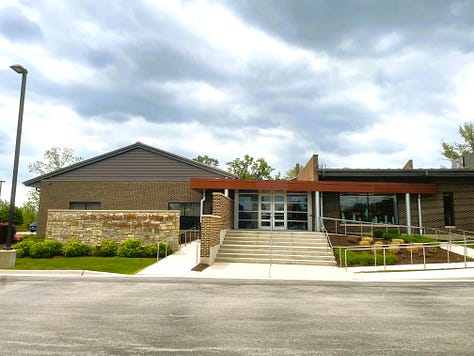


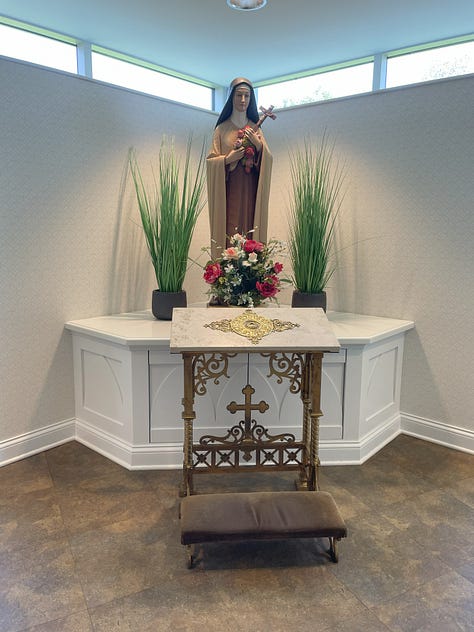
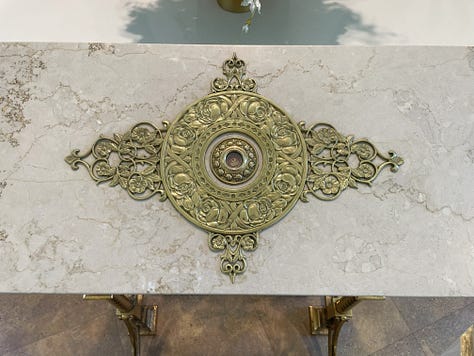
1st Class Relics of Thérèse:
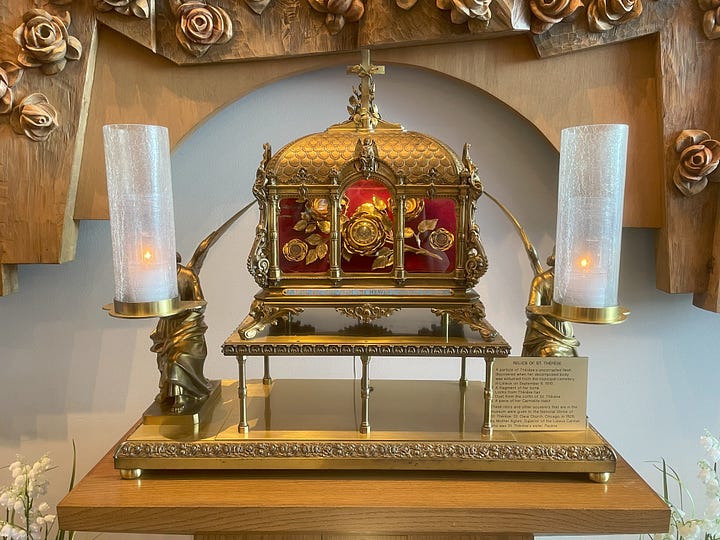
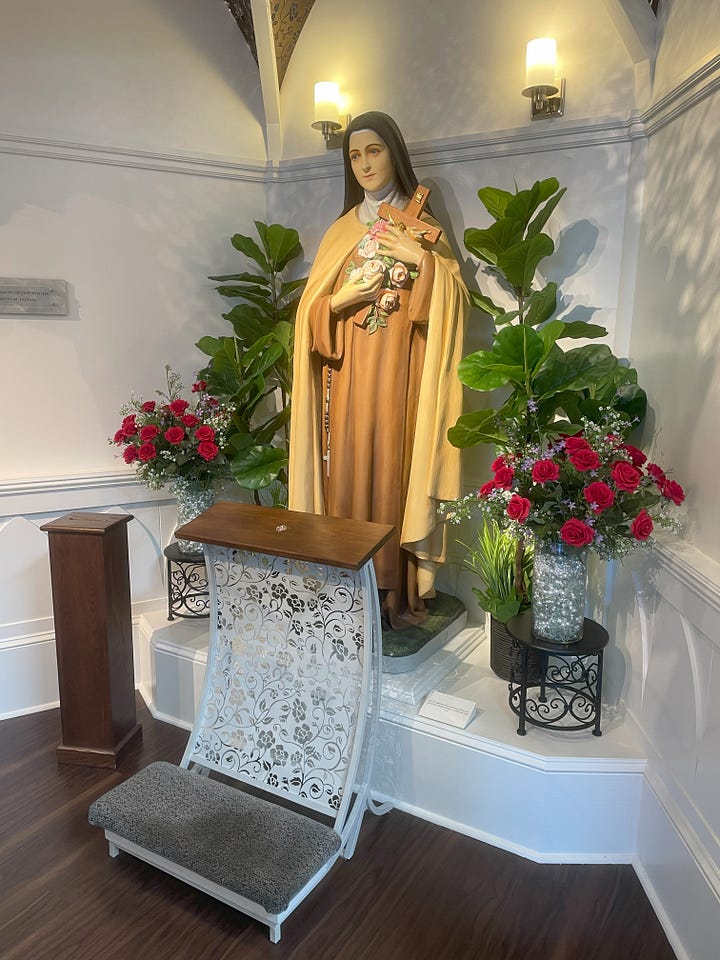
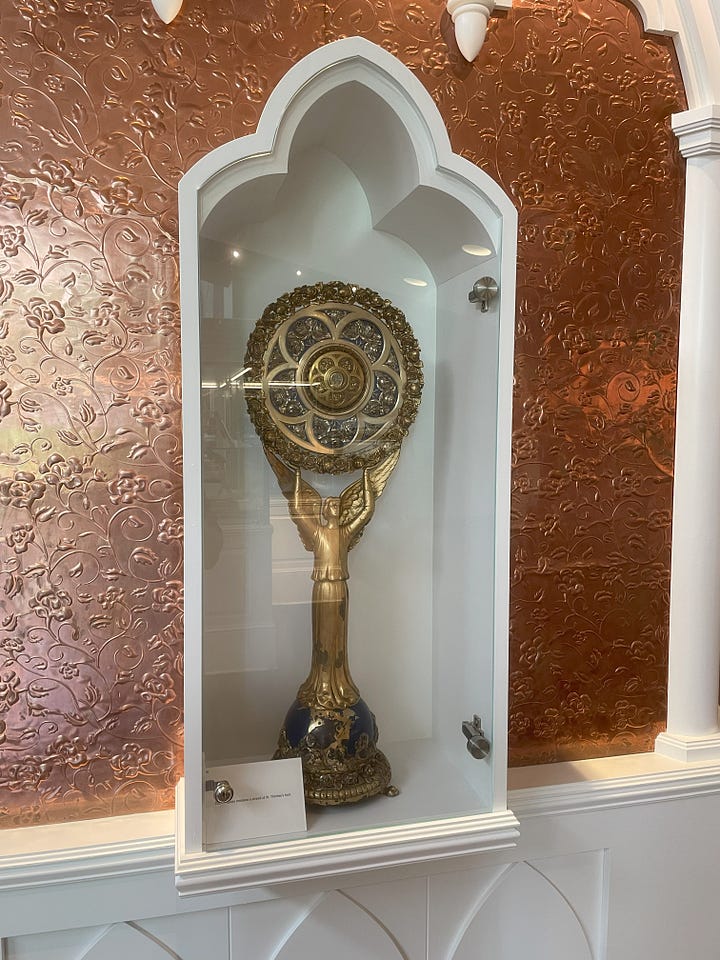

2nd Class Relics of Thérèse:

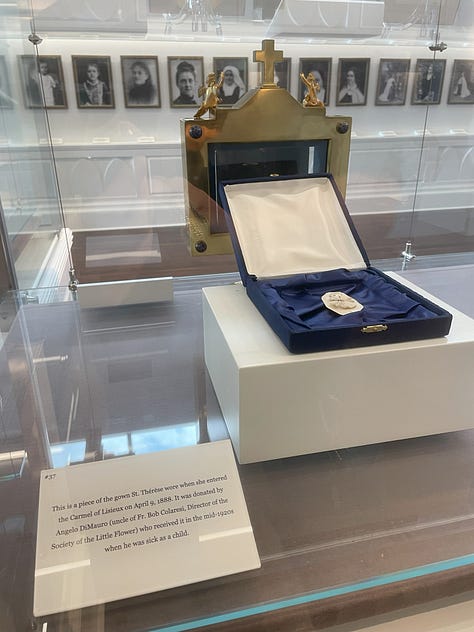

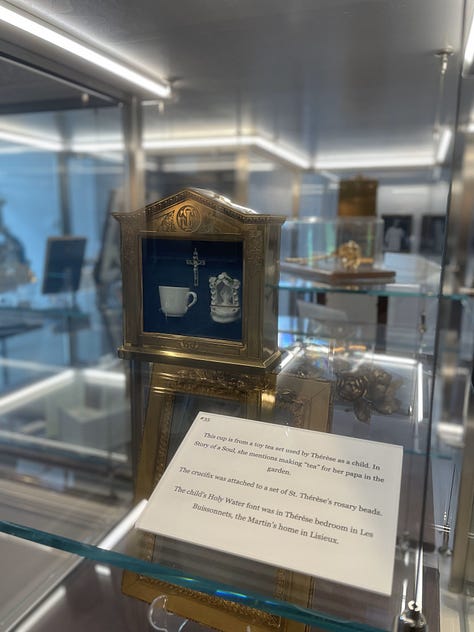

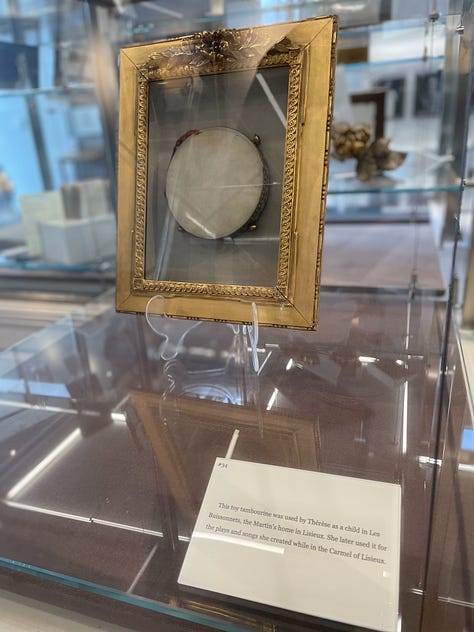

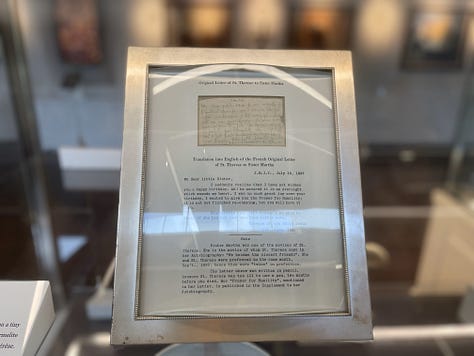
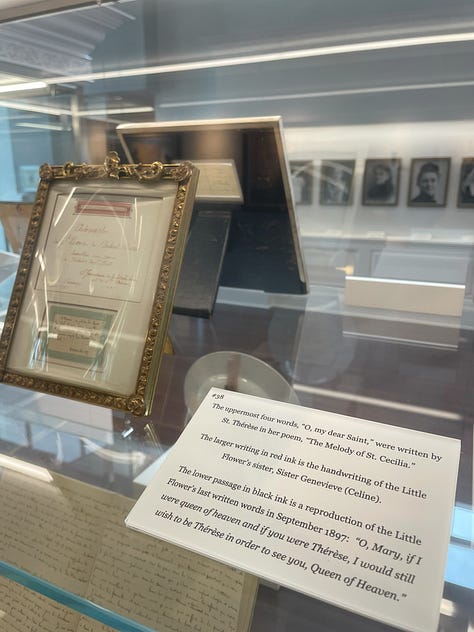
Replica of Thérèse’s Cell including Her Original Door and Tile Floor:

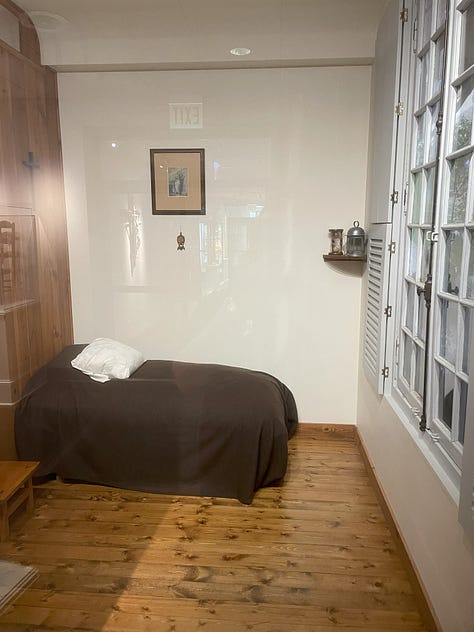
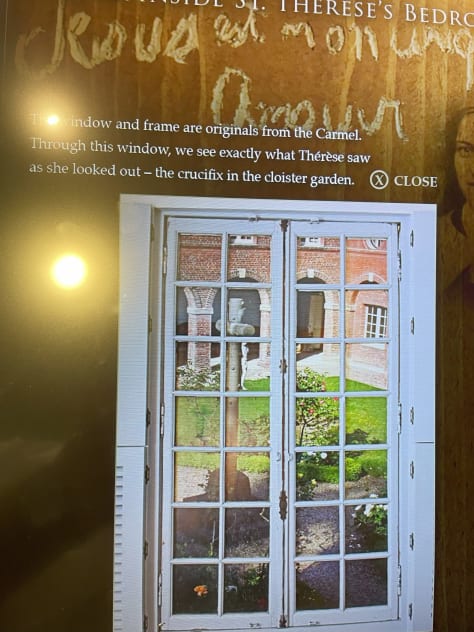


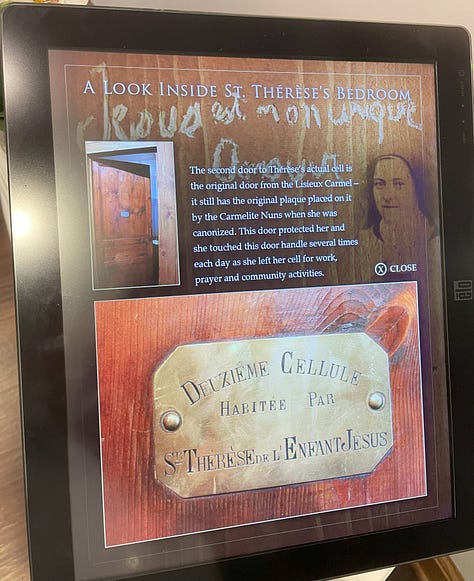
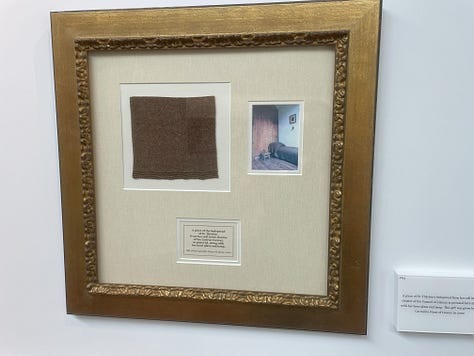
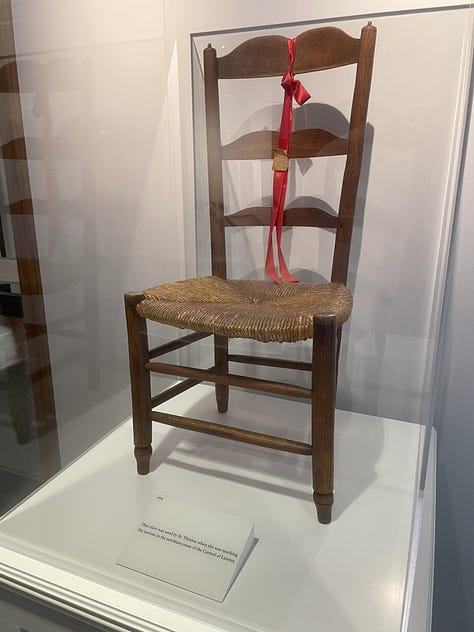

Original Painting of Thérèse by her Sister Céline:
PHOTOS FROM THE SHRINE OF ALL SAINTS (MORTON GROVE, IL)
Relic of St. Thérèse’s Hair at the Shrine of All Saints in Morton Grove, IL:

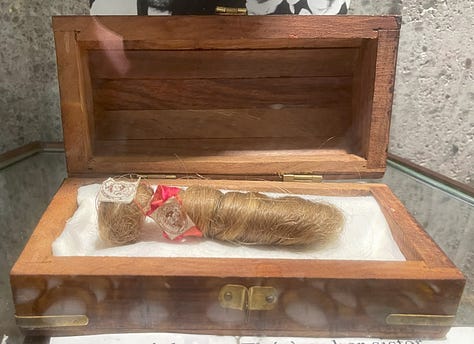
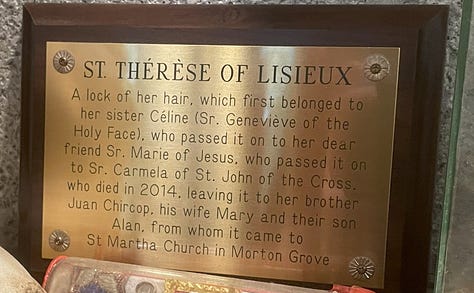
2nd Class Relics of St. Joan of Arc (died 1431):
1st Class Relics of the 40 Cristero Martyrs of 1920’s Mexico:
2nd Class Relic from one of the 16 Carmelite Martyrs of Compiegne (died 1794):
Relics of St. Catherine of Siena, St. Gianna Molla, St. Hildegard of Bingen, St. Ignatius of Loyola & St. Francis Xavier, St. Longinus, St. Louis IX, Maccabees Mother & 7 Sons, St. Thomas More, and St. Sebastian:
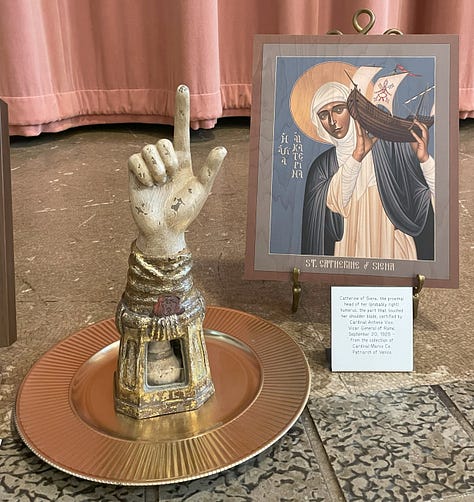

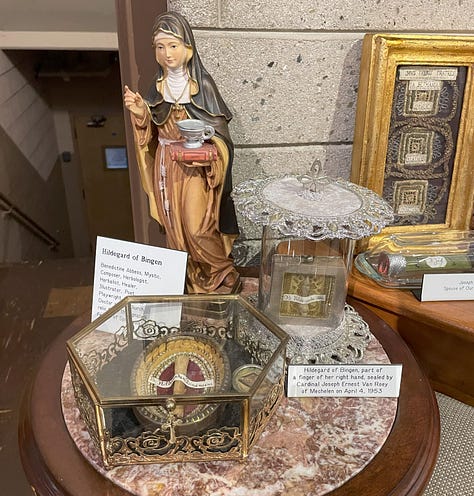



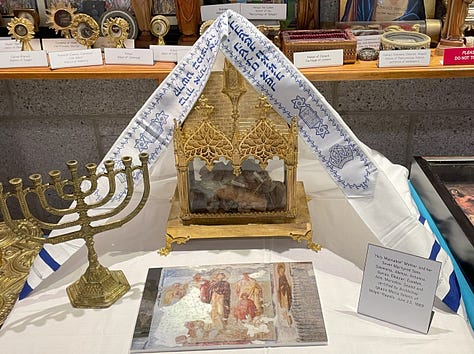
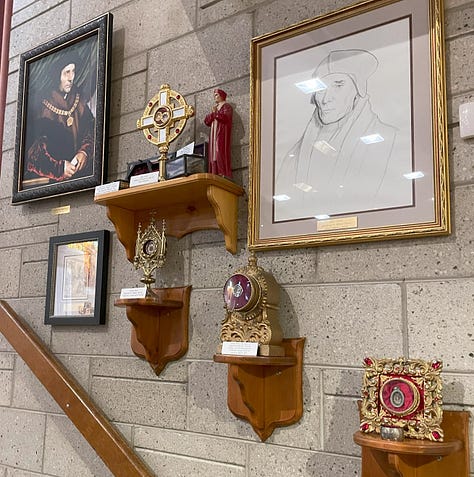




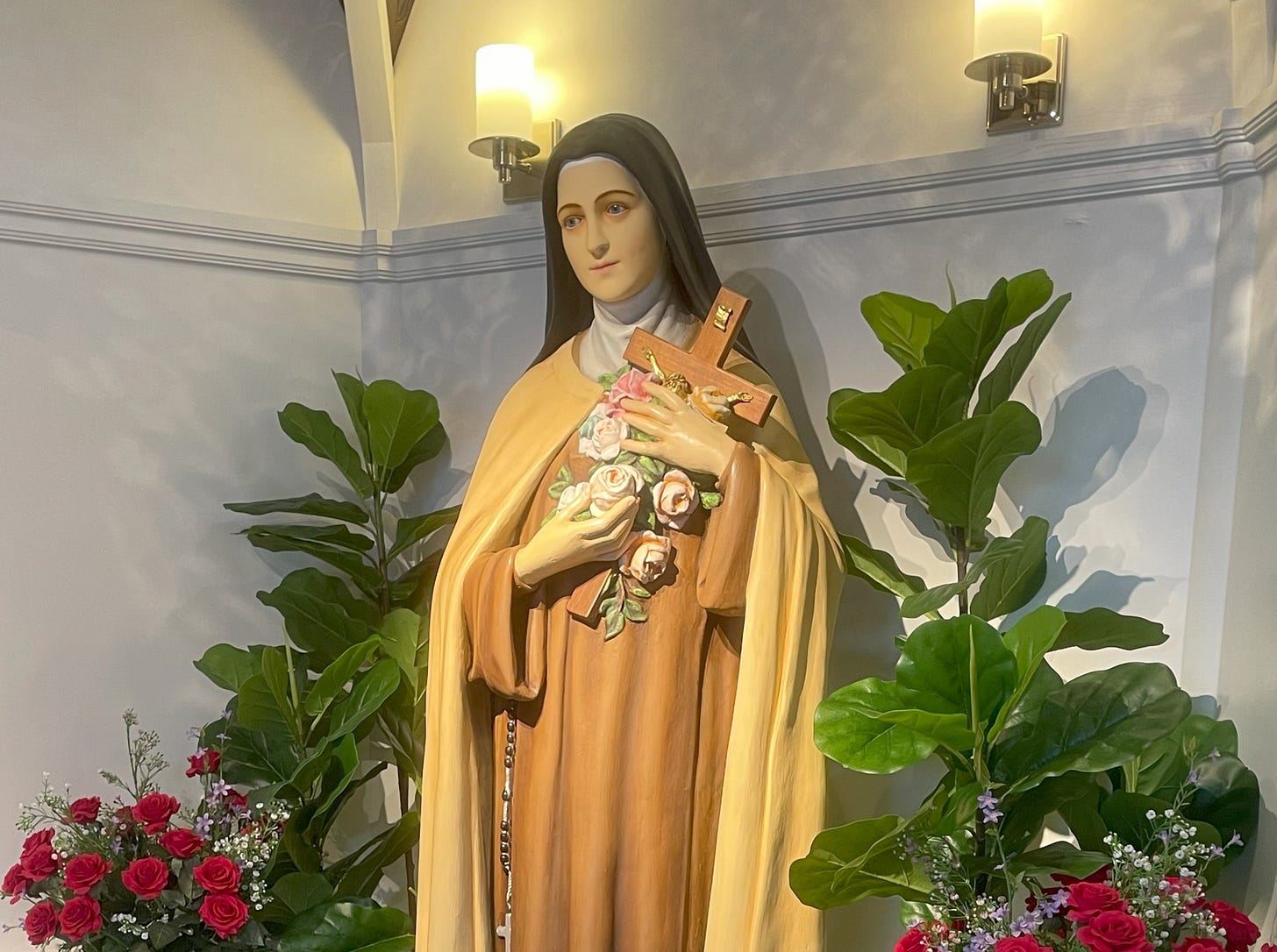
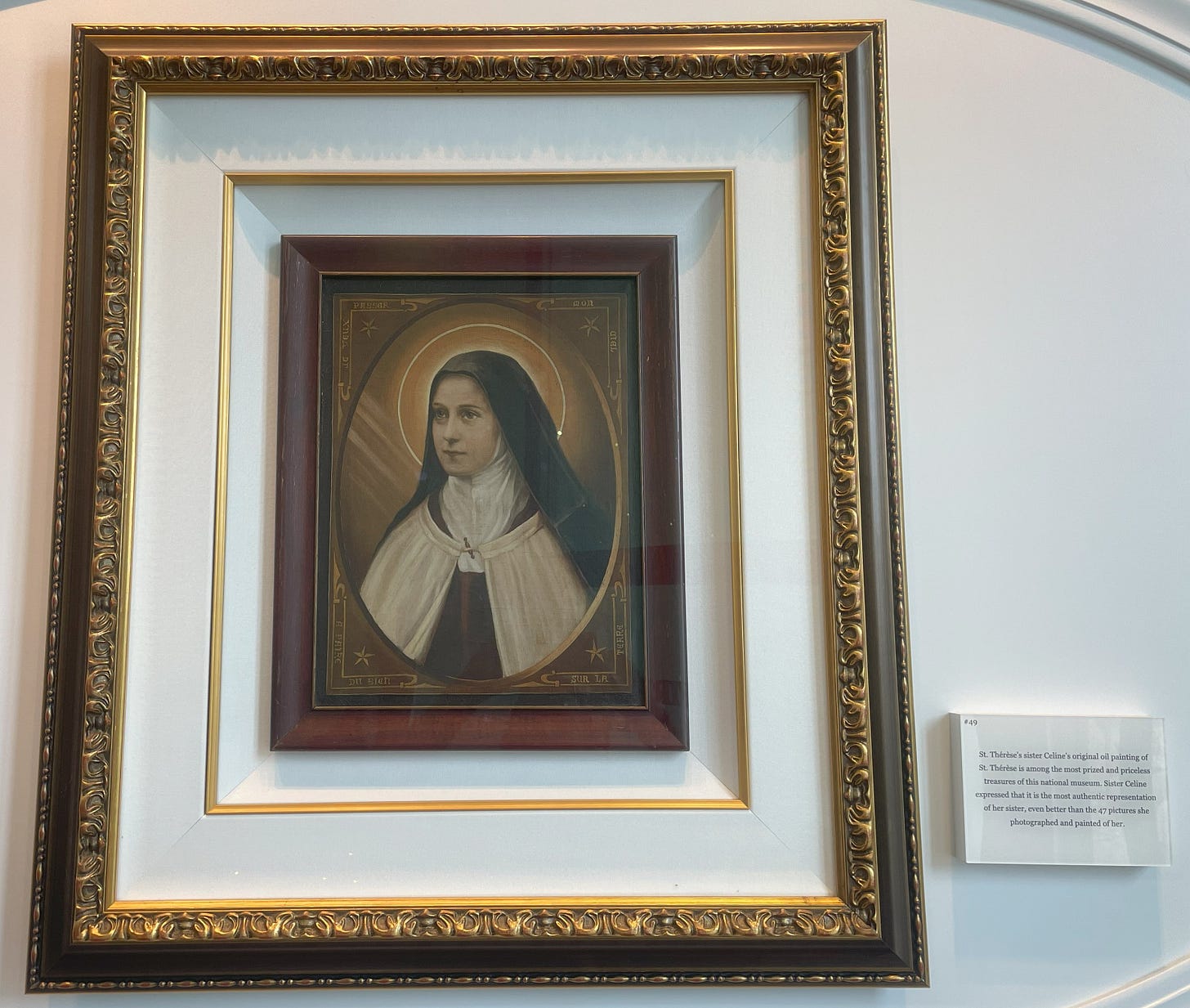



Thank you for sharing your beautiful experience with St Therese. It is very moving. I also look forward to visiting the Shrine and venerating the relics. God bless your ministry